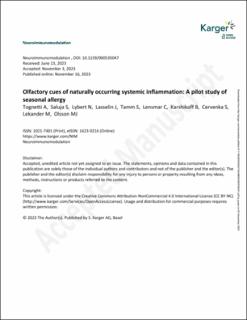| dc.contributor.author | Tognetti, Arnaud | |
| dc.contributor.author | Saluja, Supreet | |
| dc.contributor.author | Lybert, Nathalie | |
| dc.contributor.author | Lasselin, Julie | |
| dc.contributor.author | Tamm, Sandra | |
| dc.contributor.author | Lensmar, Catarina | |
| dc.contributor.author | Karshikoff, Bianka | |
| dc.contributor.author | Cervenka, Simon | |
| dc.contributor.author | Lekander, Mats | |
| dc.contributor.author | Olsson, Mats J. | |
| dc.date.accessioned | 2023-12-07T12:50:49Z | |
| dc.date.available | 2023-12-07T12:50:49Z | |
| dc.date.created | 2023-12-05T12:55:25Z | |
| dc.date.issued | 2023 | |
| dc.identifier.citation | Tognetti, A., Saluja, S., Lybert, N., Lasselin, J., Tamm, S., Lensmar, C., ... & Olsson, M. J. (2023). Olfactory cues of naturally occurring systemic inflammation: A pilot study of seasonal allergy. Neuroimmunomodulation. | en_US |
| dc.identifier.issn | 1021-7401 | |
| dc.identifier.uri | https://hdl.handle.net/11250/3106420 | |
| dc.description.abstract | Introduction: In an attempt to avoid contact with infectious individuals, humans likely respond to generalised rather than specific markers of disease. Humans may thus perceive a non-infectious individual as socially less attractive if they look (e.g., have facial discoloration), move (e.g., have a slower walking pace), or sound (e.g., sneeze) sick. This pilot study tested whether humans are averse to the body odour of non-infectious individuals with a low-grade systemic inflammation. Methods: We collected the axillary body odour of individuals with severe seasonal allergy (N = 14) and healthy controls (N = 10) during and outside the allergy season and measured serum levels of two inflammatory cytokines (tumor necrosis factor-α, interleukin-5). Independent participants (N = 67) then sampled and rated these odours on intensity and pleasantness. Results: While individuals with seasonal allergy had nominally more unpleasant and intense body odours during the allergy season - relative to outside of the allergy season and to healthy controls - these effects were not significant. When examining immune markers, the change in perceived pleasantness of an individual’s body odour (from out- to inside pollen season), was significantly related to the change in their interleukin-5 levels but not to tumor necrosis factor-α. Discussion: Our findings tentatively suggest that the human olfactory system could be sensitive to inflammation as present in a non-communicable condition. Larger replications are required to determine the role of olfaction in the perception of infectious and non-infectious (e.g., chronic diseases) conditions. | en_US |
| dc.language.iso | eng | en_US |
| dc.publisher | Karger International | en_US |
| dc.rights | Navngivelse 4.0 Internasjonal | * |
| dc.rights.uri | http://creativecommons.org/licenses/by/4.0/deed.no | * |
| dc.title | Olfactory cues of naturally occurring systemic inflammation: A pilot study of seasonal allergy | en_US |
| dc.type | Peer reviewed | en_US |
| dc.type | Journal article | en_US |
| dc.description.version | publishedVersion | en_US |
| dc.rights.holder | © The Author(s) 2023 | en_US |
| dc.subject.nsi | VDP::Medisinske Fag: 700 | en_US |
| dc.source.journal | Neuroimmunomodulation | en_US |
| dc.identifier.doi | 10.1159/000535047 | |
| dc.identifier.cristin | 2209167 | |
| cristin.ispublished | true | |
| cristin.fulltext | original | |
| cristin.qualitycode | 1 | |

